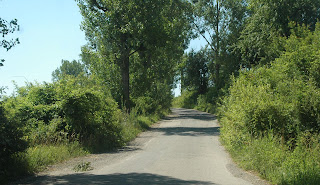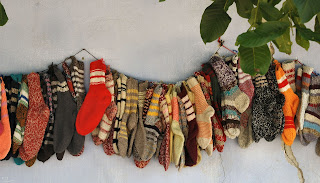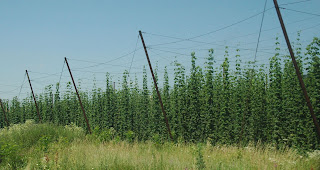We left our bucolic site on the southern outskirts of Feldioara and continued driving towards Viscri. Once we left the main highway, we had about 6km of "road from hell" — actually, it wasn't all that bad, but some of the potholes were magnificent. We got to Viscri, a small farming village populated mainly by Roma people. We could see the fortified church as we came into the village, so we had little difficulty finding it. The road up to the church from the village is a cobblestone affair, sloping fairly steeply upwards, so we decided to leave the van in the shade in the village and walk up to the church.
Have we told you we're in a bit of a heatwave here at the moment? — regular temperatures topping 36 degrees during the day. Add to this that the fridge in the van is on the fritz, and you can understand that we are being somewhat innovative about our eating at the moment. Don't expect we'll be able to get the appropriate repairs before Hungary. We're also conserving our gas (which could have been running our fridge) because all the solutions offered to us in Romania have come up dry. We do, however, know that there is a CampinGaz refilling service outside Budapest, and there might be others around Hungary.
On the way up to the church, we passed numerous displays of local craft-work for sale, really beautiful. We decided to call in on the way back down and check them out a bit more carefully.
Anyway, Viscri Deutsch-Weißkirch. This place is amazing. It was first constructed as a wooden church in around 1100-1120 by the Szeklers. Soon afterwards, when the Szeklers were resettled elsewhere, Saxon immigrants took it over. In the 13th century, a tower house and a ring wall were added. It was at this time that the original wooden structures were replaced by stone — but the interiors and the roofs were still entirely of wood.
Further fortifications were added in the 15th century, to provide a refuge for the villagers in response to increased raids by the Turks. Further enhancements to the fortifications continued through the 16th century, and two new towers were erected in the mid-17th century. in the early 18th century, the church had become rather dilapidated, so it was given a thorough renewal. The gate tower, which also served as a bell tower, was replaced in 1650, pn the foundations of its predecessor.
The projecting wooden hoardings of the tower and bastions could, by the simple expedient of lifting floorboards, could function as machiolations, where rocks and other heavy objects could be dropped on attackers. The bastions, ring wall towers and the ring wall itself have loopholes to allow weapons to be fires outwards and downwards at hostile forces.
Fortified churches are common in this part of Romania, and are a sure sign of the turbulent history of this part of the world.
The church itself is fascinating. The wood it is fitted out with is old, creaking, and at times apparently totally inadequate — but it serves its purpose. Went up into the choir stalls, and had the feeling that any chorister should be wearing a safety belt! But it is a church that functions to this very day. It's no surprise that, as a German church, it is Lutheran in character.
The organ somewhat outshines the rest of the church. It was built in 1817 by the renowned organ builder, Johann Thois. It incorporates an altar, flanked by Corinthian columns and pilasters, with an altarpiece depicting "Let the children come to me" (Matt.10, 13-16). The organ was fully restored in 2007/08 — it's a pity we didn't get the opportunity to hear it played!
Outside the church, but within the rooms in the ring wall, they have set up a museum of local ethnographic history. There are church-related exhibits, local village day-to-day functioning — for example, the church provided a lard tower, where the villagers could store their lard and hams in cool storage — the only downside to this was that you only had access to it on Sundays, when you could 'withdraw' your week's supply — and there were strict controls to ensure that you only took supplies from your own stock!
After leaving the church, we wandered the village. Many of the houses are of historic significance — one was even purchased recently by the Prince of Wales and converted into a guesthouse, retaining all of its historic value. We also revisited the sellers of local arts and crafts!
Then we left Viscri, by the same road we had come in on — after all, there were now no surprises left for us!
Our plan for tomorrow was to be Sighişoara, another World Heritage site, so we directed ourselves towards Camping Aquaris in Sighişoara, where we settled in for the night. When we got there, however, and looked at the weather forecasts — 36° and up — we decided we might be better off on the road, where we can keep cool with the van's ventilation system, and then we could return to Sighişoara in a couple of days when the weather starts to cool down a little!
As a little aside, for those who have a love of poetry, here is a little (anonymous) poem that was on display in the Weißkirch ...
Deutsch-Weißkirch auf Wiedersehen
Behüt dich Gott, mein stilles trautes Dörfchen
nun lebet wohl, ihr lieben Menschen mein,
ich muß nun fort, wohl in die weite Ferne,
so lange Zeit darf ich nicht bei euch sein.
Deutsch-Weißkirch, wie bist du schön,
Deutsch-Weißkirch, auf Wiedersehen.
Deutsch-Weißkirch, auf Wiedersehen.
Du kleines helles Abendglöckchen, läute,
oh komm und tröste mir mein trauernd Herz,
du stolze Burg mit deinen hohen Mauern,
hilf tragen mir in meinem Trennungsschmerz.
Deutsch-Weißkirch, wie bist du schön,
Deutsch-Weißkirch, auf Wiedersehen.
Deutsch-Weißkirch, auf Wiedersehen.
In deinen Höhen war ich stets zu Hause,
mit Vogelsang und Sonne wohlbestellt,
du wolltest schützen mich vor dem Gebrause
und vor dem Sturm der allzu lauten Welt.
Deutsch-Weißkirch, wie bist du schön,
Deutsch-Weißkirch, auf Wiedersehen.
Deutsch-Weißkirch, auf Wiedersehen.
Du weißt allein von meinen schönsten Stunden,
hab dir mein ganzes junges Herz vertraut,
dir durfte freudig ich mein Glück verkünden,
und du hast still und schweigsam zugeschaut.
Deutsch-Weißkirch, wie bist du schön,
Deutsch-Weißkirch, auf Wiedersehen.
Deutsch-Weißkirch, auf Wiedersehen.
God be with you, my quiet cosy village,
Live well, my dear friends,
I must leave for far places
and cannot be with you for a long time.
Live well, my dear friends,
I must leave for far places
and cannot be with you for a long time.
German White-Church, how beautiful you are,
German White-Church, goodbye.
German White-Church, goodbye.
Ring, you small bright evening bell,
oh come and comfort my sorrowing heart,
You proud castle with your high walls,
support me in my parting pain.
German White-Church ...
In your heights I was always at home,
blessed with bird-song and the sun,
You wished to guard me from the thunder
and from the storm of the all too noisy world.
German White-Church ...
You alone know my most beautiful hours,
I have trusted to you my whole young heart,
I could joyfully proclaim my joy in you,
and you have watched, still and silent.
German White-Church ...
Distance driven — today, 73 miles ( 118 km ); to date, 23,480 miles ( 37,788 km )






































Well darn it all Warren, I actually had almost understood the Deutsch for myself when I got to the last verse, I couldn't believe it. Mauern got me. I have spent all day doing three pages of thesis but they seem ok. So 3 down, 397 to go. Am going to have a nap, Have been at it since 5 this morning. Damned cat next door caught a rosella and drowned the poor thing in our pool.-dark green pool! love all the wild life shots. The cranes are high fliers aren't they? Loved that black mare and foal yesterday too. Are your shoes dry yet? Love Ya, Cathy
ReplyDeleteComputer just lost my half page response to my latest catch-up of your mighty blog :( !!!!!
ReplyDeleteNot going to re-type.
May cool breezes bless your days and your unending discovery of fascinating places continue.
Cold and wet in Adelaide - as it should be at this time of year.
Love from your brother and brother-in-law, Russell :)